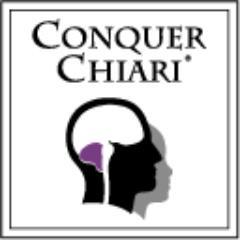
#CONQUER CHIARI SYMPTOMS SERIES#
Genitori L, Peretta P, Nurisso C, Macinante L, Mussa F (2000) Chiari type I anomalies in children and adolescents: minimally invasive management in a series of 53 cases. Wu YW, Chin CT, Chan KM, Barkovich AJ, Ferriero DM (1999) Pediatric Chiari I malformations: do clinical and radiologic features correlate? Neurology 53(6):1271–1276 BMC Musculoskelet Disord 10(Suppl 1):S1–S11 Pediatr Neurol 40(6):449–454įernandez AA, Guerrero AI, Martinez MI, Vazquez ME, Fernandez JB, Octavio CI et al (2009) Malformations of the craniocervical junction (Chiari type I and syringomyelia: classification, diagnosis and treatment). Neurosurgery 44(5):1005–1017Īitken LA, Lindan CE, Sidney S, Gupta N, Barkovich AJ, Sorel M et al (2009) Chiari type I malformation in a pediatric population. Milhorat TH, Chou MW, Trinidad EM, Kula RW, Mandell M, Wolpert C et al (1999) Chiari I malformation redefined: clinical and radiographic findings for 364 symptomatic patients. An analysis of presentation, management, and long-term outcome. J Genet Couns 12(4):297–311ĭyste GN, Menezes AH, VanGilder JC (1989) Symptomatic Chiari malformations. Speer MC, Enterline DS, Mehltretter L, Hammock P, Joseph J, Dickerson M et al (2014) Chiari type i malformation with or without syringomyelia: prevalence and genetics. Springer Science + Business Media, New York, pp 83–92 In: Tubbs RS, Oakes WJ (eds) The Chiari malformations.

Heiss J (2013) Epidemiology of the Chiari I malformation. National Institute of Neurological Disorders and Stoke. Patient and physician education about CM I may permit early intervention and the prevention of further deterioration and patient suffering. CM I can be a challenging condition for patients and physicians, during both the search for diagnosis and management of symptoms. Fear was the most frequent emotion elicited at the time of correct diagnosis (42.19 %). Common misdiagnoses were classified as psychological (19.26 %) and neurological (19.26 %). CM I diagnosis was found incidentally for 24.87 % of participants. Average time to diagnosis from first physician visit to diagnosis was 3.43 years, and only 8.46 % of patients had previous awareness of CM. Neurocognitive comorbidities included memory difficulties (43.88 %) and aphasia (43.75 %) and psychological disorders such as depression (31.77 %) and anxiety disorders (19.92 %) were reported.


Pain was the most frequently reported symptom (76.69 %) experienced prior to diagnosis with headaches implicated most often (73.44 %). Participants were 768 individuals with CM I and were predominantly female (86.8 %) and Caucasian (93.8 %) with an average age of 35 years. Analyses included descriptive statistics to study body system impact and patient diagnostic experiences. The current research is one component of a large investigation designed to collect information from individuals with CM through the online Conquer Chiari Patient Registry questionnaire.

This study reports from the only national, online patient registry available, the symptoms, comorbid neurocognitive and psychological conditions, and diagnostic experiences of patients living with CM type I (CM I). Chiari malformation (CM) is a condition in which cerebellar tonsillar ectopia may manifest with various clinical presentations.


 0 kommentar(er)
0 kommentar(er)
